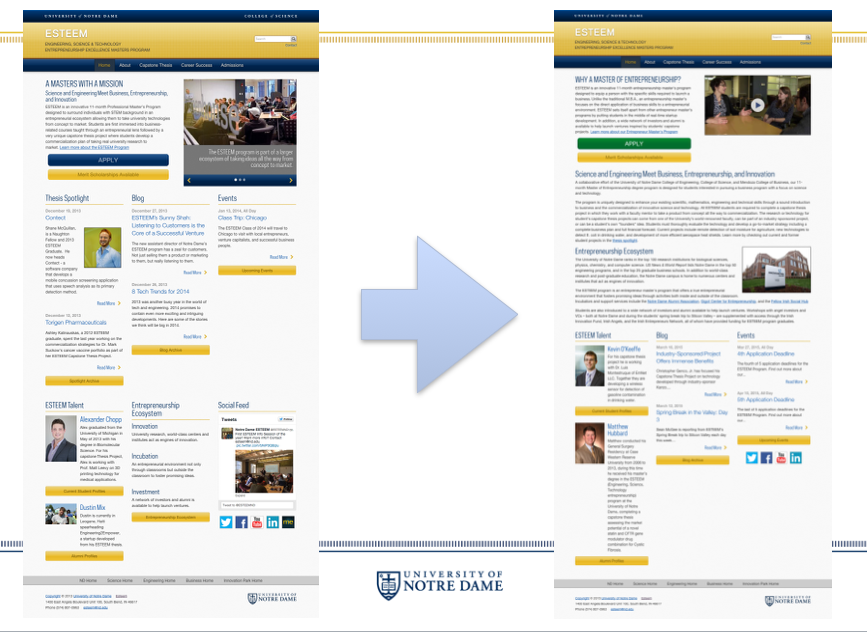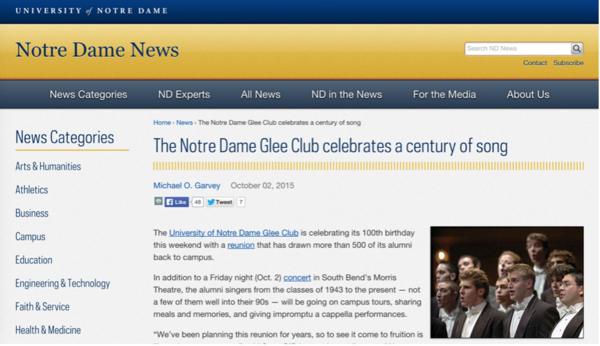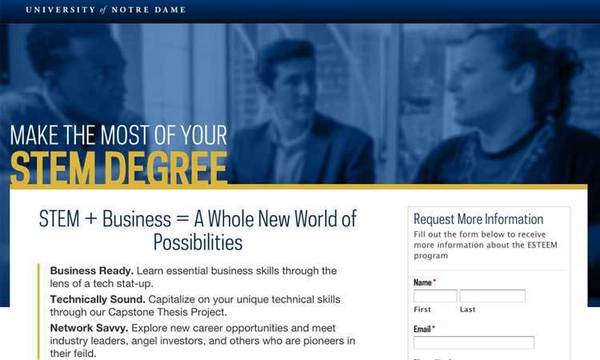This presentation was originally given at the 2015 High Ed Web Association conference in Milwaukee, Wisconsin.
Since January 2015, Notre Dame has actively engaged in marketing research and data analysis in an effort to better understand and optimize both it's central communications efforts and the ability of certain programs to attract quality applicants. With 500+ website's hosted on the University's CMS, Conductor -- which by default include's Google's Universal Analytics and cross-domain tracking -- there is no shortage of information to aid these attempts.
Data Types
In this article we'll discuss how data can help us improve our strategies for lead generation and content marketing. Although most web-based businesses also include ecommerce, and the University does sell merchandise and tickets online, those analyses will not be discussed.
Lead Generation
When we think about lead generation in higher education, we're primarily concerned with attracting applications. Applications for undergraduate admission, to graduate programs, executive certification courses, and for open faculty and staff positions on campus. Lead generation data can also be used to help increase the effectiveness of fund-raising campaigns. Although large donations are unlikely to come in via digital properties, young alumni or friends of the University are often willing to make modest gifts online.
Content Marketing
The second bloc of users we consider are for content marketing. This data is going to be related to the University's general brand awareness, our daily news and events, and our ability to show up in search results. Brand awareness will include our ability to attract an audience to our large news stories, and to funnel that audience to other key areas and engage with the University online. It will also include data about the perception of the Notre Dame brand and the news that comes out of campus. We also collect search engine data and attempt to optimize certain page or stories to appear for results that users may not always associate with Notre Dame.
Lead Generation - ESTEEM Program
The ESTEEM program, or Engineering, Science & Technology Entrepreneurship Excellence Masters Program, is a joint effort between the colleges of Business, Science, and Engineering. The one year graduate program has been available for about 8 years and aims to educate students with STEM backgrounds on best business practices for technology and science based industries with a focus on startup and innovation. The goals of the ESTEEM program were fairly straightforward: to increase the number of applicants while also increasing the diversity of the applicant pool.
Getting started was more difficult that it would seem, mainly because the full name of the program is much too long to feature on advertisements and in elevator text but the acronym is not at all descriptive of the type of education that the program provides. However, this was not going to be changed by the start of our campaign in the middle of the school year, so we worked with what we had. A description of initial results that includes more descriptive SEO changes were previously outlined in May 2015.
The Process
The process for the beginning of the campaign is comprised of four broad steps. An analysis of the homepage layout, an SEO audit, a market analysis for pay-per-click traffic, and landing page design & testing during initial optimization of the PPC campaign. Since this presentation was originally given in the design track of the High Ed Web conference, we'll focus on homepage layout and landing page design.
1. Homepage Layout
The user flow with the original homepage design largely consisted of Homepage > About > Other Information Pages > Apply/Contact Us. This flow fails to minimize the steps between initial contact and prospect acquisition and although a one year graduate program is the type of product that lends itself to such thoroughness by the users, it's still advisable to streamline these interactions when possible. In order to do this we had two main areas of improvement. One, to A/B test simply the color of the apply button in order to make it more clear to users what we want them to do. The second was to slightly tweak the layout of the homepage to provide for more robust content to be available. The effect of this change should be two-fold. It will provide enough space to accurately and more completely describe the program to prospective students, and also allow for enough robust and static content to be valuable for SEO purposes.
Although all websites on Conductor are built by the Marketing Communications Web Team to be responsive and as accessible as possible, they are not often optimized to meet their goals. The original ESTEEM homepage featured an elevator pitch, three calls to action, a carousel/slider wit no calls to action, and a three column main area layout that left little room for descriptive content. The main call-to-action, a button prompting you to apply, blended into the rest of the site and could probably be A/B tested. Based on heat map data we found that users would regularly try to to interact with the carousel, thinking it would link them through to a more descriptive page of the featured content, it did not. The bottom right of the page was largely wasted space, featuring a social feed and three bullet point reasons for applying to the program without enough description.
The new homepage layout, which also included a video describing the program in place of the previous carousel, resulted in the following change in metrics.
- Increased application button clicks by 15%
- Decreased flow to "About" page by 10%
- Increased flow to "Admissions/Contact Us" pages by 12%
- Increased keyword positions by an average of 5.2 spots on SERPS
Although the change in organic rankings may not usually be considered a design metric, it can be valuable to show that making well-informed design decisions has positive effects on things like SEO.

2. Landing Page Design
As mentioned in previous articles, It's generally best practice to create specific pages for each PPC campaign that you're running. This allows you to optimize the campaign with the most precision possible without having to worry about hurting the content or architecture of your public facing website. We started with a single page design that's typical of PPC landing pages, with bullet points laid out to the left and a form and additional easy to read data on the right. On mobile, the user sees the form first. The only difference between the two pages was the presence of an apply button above the short form that led you to the full application. Removing the apply button led to an increase in conversions, likely because users were given only one clear option for making contact and didn't have a choice to make, subconscious or otherwise.
Attention was then focused on iterating on this landing page. Originally, a custom page was set up using unique copy geared specifically toward engineering students and paired with specialized engineering focused ad copy on the PPC end. This specified landing page yielded 25% more conversions than the original when A/B tested against the original for engineering ads. Custom pages were then designed for each specific area of interest. Including the general STEM and engineering landing pages, biology, chemistry, and math each have their own PPC ad copy and corresponding landing pages, with slightly different imagery and/or copy. As we continued to specialize our ads and landers, our cost-per-click decreased significantly, allowing us to receive more traffic for the same budget we had previously defined.

The full recruiting cycle for the ESTEEM program is almost the complete academic year, from August through April. We began the initial campaign in mid December, and had decent results for such an abbreviated period. When the class of 2016 was compared to the average of the previous three classes, we hit both of our goals. We increased overall admissions by over 100% while also increasing the diversity of our applicant pool. It's unlikely that subsequent campaigns will be as dramatic, since implementing a campaign after years of having nothing will more than likely always show significant gains.

Content Marketing
In addition to lead generation Notre Dame has actively engaged in marketing research and data analysis in an effort to better understand and optimize it's central communications efforts. Metrics that we pay attention to for this data set include user acquisition data, user flow information, text analysis, and headline optimization. By keeping track of acquisition data, in tandem with the other data, we can better provide our users with the content that is of most interest to them. We are able to shape leader text and headlines based on there likelihood to succeed on different channels, tweaking each slightly for Facebook, Twitter, LinkedIn, new outlets, or organic search.
We are also constantly analyzing better ways to provide users already on our website with the stories and information that they are interested in. This effort has the benefit of not only a better user experience, but also keeping new visitors engaged in the Notre Dame brand for a longer period of time. Allowing us to communicate our message to a larger audience and reach people who may have otherwise had no interest in the University. We first removed excerpts and bylines from the homepage news stories, leaving just titles and images, taking an approach to news sites like USA Today or ESPN. This simple design change significantly increased click through rates from the homepage to news stories and also increases the number of visible stories on the landing page. We then attempted to experiment with personalized content, the results can be seen plainly in a recent viral news story. A typical Notre Dame news page looks like this:

Providing a story with no recommendations for additional content, calls to action, or featured information. On September 21, a research article about co-sleeping and breastfeeding was published that went viral on Facebook and peaked at about 50,000 sessions/day. To take advantage of this traffic, which was more than 90% mobile, we manually adjusted the template to include areas that we wanted to drive traffic to as well as features that we expected those users to be interested in.
The results were immediate. Cross domain bounce rate was reduced from 92% to 78%, traffic to cosleeping.nd.edu increased by 800% over it's previous daily average for the period that the article was popular.

Interestingly, traffic to additional Notre Dame research and features did not increase significantly, further suggesting the importance of personalized content to optimize the user experience. To facilitate this, we are currently working on creating an accurate data model to use Amazon Web Service's machine learning tool to better predict articles users are interested in. Since we build Conductor in-house and it runs on AWS, we hope to implement a dynamic, personalized content delivery system into the next iteration of the University news website along with the title/image strategy determined during our A/B testing.

